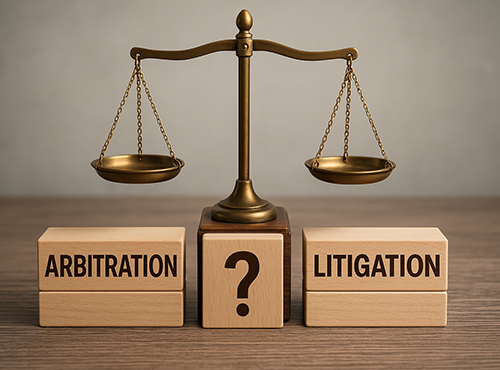Mutual Divorce in India – Process, Timeline and Cost
In today’s fast-paced world, many couples are choosing to end their marriage through a mutual divorce rather than entering into lengthy and emotionally draining legal battles. A mutually agreed divorce means that both husband and wife come together with a shared decision to dissolve the marriage peacefully, without blaming each other or engaging in unnecessary conflicts. This form of separation is based on mutual consent, which not only saves time but also reduces financial and emotional stress.

The mutual divorce process in India is designed to be simpler, more respectful, and less adversarial compared to a contested divorce. Instead of years of litigation, couples can file a mutual divorce application supported by a mutual agreement that clearly outlines key aspects like alimony, child custody, and property settlement. Once these matters are settled, the court ensures that the rights of both parties are protected before granting the final decree.
Legally, the foundation of a mutual divorce process is provided under Section 13B of Hindu Marriage Act 1955. This provision allows couples to jointly submit mutual divorce papers before a family court when they meet the necessary conditions for divorce, such as being married for at least one year and living separately for a period of time. Depending on the circumstances, the mutual divorce time period usually ranges from 6 to 18 months, though it can sometimes be shorter if the cooling-off period is waived.
Couples also need to prepare the documents, which include marriage certificates, identity proofs, and evidence of separation. Hiring an experienced mutual divorce lawyer is highly recommended, as a lawyer ensures that the petition is drafted properly, all paperwork is accurate, and the court proceedings are handled smoothly. While the mutual divorce cost in India can vary depending on the complexity of the case and the city, it is generally far more affordable than contested proceedings.
In short, opting for a mutual divorce gives couples the opportunity to part ways with dignity, respect, and fairness, while staying fully compliant with the legal framework.
What is Mutual Divorce?
A mutual divorce is a legal process where both husband and wife agree to end their marriage amicably. Unlike a contested divorce, where one spouse files a case against the other, a mutually agreed divorce is based on mutual consent. This means there is no blame game, no prolonged courtroom battle, and both parties willingly accept that living together is no longer possible.
Under Indian law, the mutual divorce process is primarily governed by Section 13B of Hindu Marriage Act 1955. According to this section, when both spouses have been living separately for at least one year and have mutually decided that the marriage cannot continue, they can file an application before the family court. The law ensures that both partners’ rights are protected and that separation happens in a fair, dignified, and legally valid manner.
Mutual Divorce vs Contested Divorce
Mutual Divorce:
- Based on mutual consent.
- Requires both parties to agree on issues like alimony, child custody, and property division.
- The process is relatively faster, usually taking about 6–18 months, depending on the time period and whether the cooling off period (normally 6 months) is waived by the court.
- Less expensive and emotionally less stressful.
Contested Divorce:
- One partner files against the other, often on grounds like cruelty, adultery, or desertion.
- Involves multiple hearings, evidence, and witness examination.
- Can take several years to conclude.
- Generally costlier due to prolonged litigation.
The conditions for mutual divorce make it a more practical and peaceful choice for couples who wish to separate without conflict. By filing a mutual divorce application, couples can move forward with dignity, complete the process in a shorter time, and avoid the stress of a contested legal battle.
Legal Provisions for Mutual Divorce
The mutual divorce process in India is clearly defined by law to ensure fairness, dignity, and respect for both spouses. The main statutory framework governing a mutually agreed divorce is found in Section 13B of Hindu Marriage Act 1955, along with provisions under the Special Marriage Act 1954 for couples married under civil law.
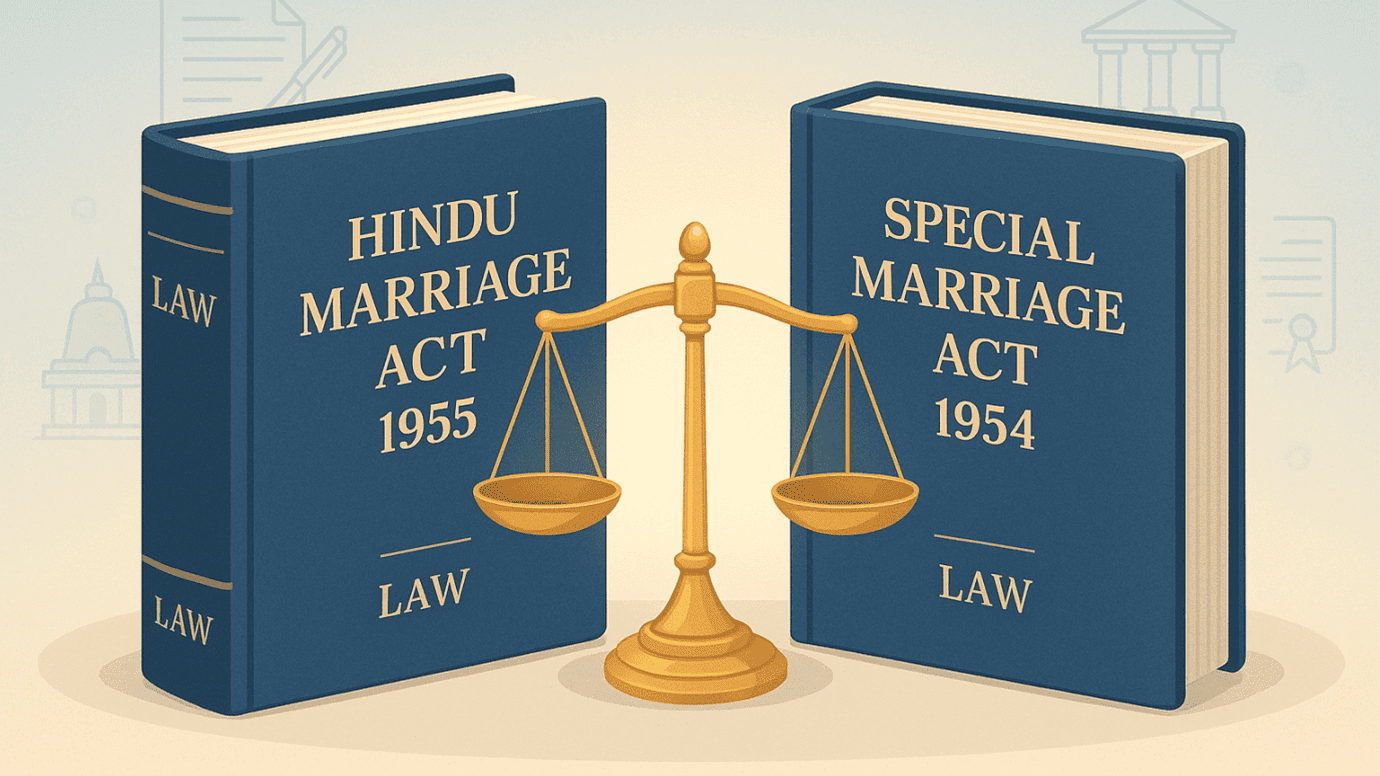
1. Section 13B of Hindu Marriage Act 1955
For Hindus, Sikhs, Buddhists, and Jains, the mutual divorce process is regulated by Section 13B of Hindu Marriage Act 1955. This law allows couples to file application jointly before a family court when:
- They have been married for at least one year.
- They have lived separately for a period of one year or more.
- They have reached a mutual divorce agreement on key issues such as alimony, child custody, and division of property.
The law requires submission of mutual divorce papers along with the documents, such as marriage certificate, proof of residence, and identity documents. Once the first motion is filed, the court usually grants a cooling off period of six months. This allows couples to reconsider their decision. However, courts can waive this waiting period if the marriage is beyond reconciliation, thereby reducing the time period.
2. Applicability for Hindus, Sikhs, Buddhists, and Jains
The Section 13B provisions specifically apply to communities governed by Hindu personal law. This means Hindus, Sikhs, Buddhists, and Jains can directly rely on this statute for a mutual consent. A mutual divorce lawyer plays a crucial role in drafting the mutual divorce papers, ensuring compliance with the conditions and guiding clients through hearings.
3. Provisions under Special Marriage Act 1954
For interfaith marriages or couples married under civil law, the Special Marriage Act 1954 provides the framework for a mutually agreed divorce. The procedure is similar: both parties must file an application, submit the required divorce papers, and show the court that they have mutually resolved issues like maintenance and custody.
This Act ensures that the mutual divorce process in India is accessible not only to those governed by Hindu law but also to couples of different faiths who registered their marriage under the civil code.
In essence, whether filed under Section 13B of Hindu Marriage Act or the Special Marriage Act, the goal of a mutual divorce remains the same — to provide couples a dignified and conflict-free way to part ways. With the right lawyer, proper documents and clarity on the mutual divorce cost, couples can complete the process smoothly and in compliance with all legal provisions.
Conditions Required for Mutual Divorce in India
The mutual divorce process in India is designed to ensure that couples part ways only after fulfilling certain legal requirements. These conditions are meant to safeguard the interests of both spouses and confirm that the decision to separate is voluntary, genuine, and free from coercion.

- Minimum Duration of Marriage: To begin the process, the couple must have been legally married for at least one year. This applies to both Section 13B petitions and cases filed under the Special Marriage Act 1954. A mutual divorce application filed before the completion of one year is not maintainable in court.
- Separation for at Least One Year: Another crucial condition is that the husband and wife must have lived separately for at least one year prior to filing the mutual divorce application. “Living separately” does not necessarily mean staying in different homes; it may also mean living under the same roof but without fulfilling marital obligations. This separation period is essential before the court accepts mutual divorce papers.
- Mutual Consent of Both Spouses: The very foundation of a mutually agreed divorce is the mutual consent. Both parties must willingly agree to dissolve the marriage without any external pressure. If one spouse withdraws consent at any point before the final decree, the mutual divorce process comes to a halt.
Importance of Legal Assistance
Meeting these conditions requires careful preparation of documents and agreements. A skilled mutual divorce lawyer ensures that all documents required for mutual divorce are complete, that the settlement terms are legally enforceable, and that the process is handled smoothly. This also helps in controlling the mutual divorce cost, as errors or delays can otherwise make the process expensive.
Step-by-Step Process of Filing Mutual Divorce in India
The mutual divorce process in India is designed to be smoother and quicker than a contested divorce. However, it still follows a structured legal framework to ensure fairness and compliance with the law. Below is a detailed breakdown of each stage of the process that couples must go through when seeking a mutually agreed divorce.
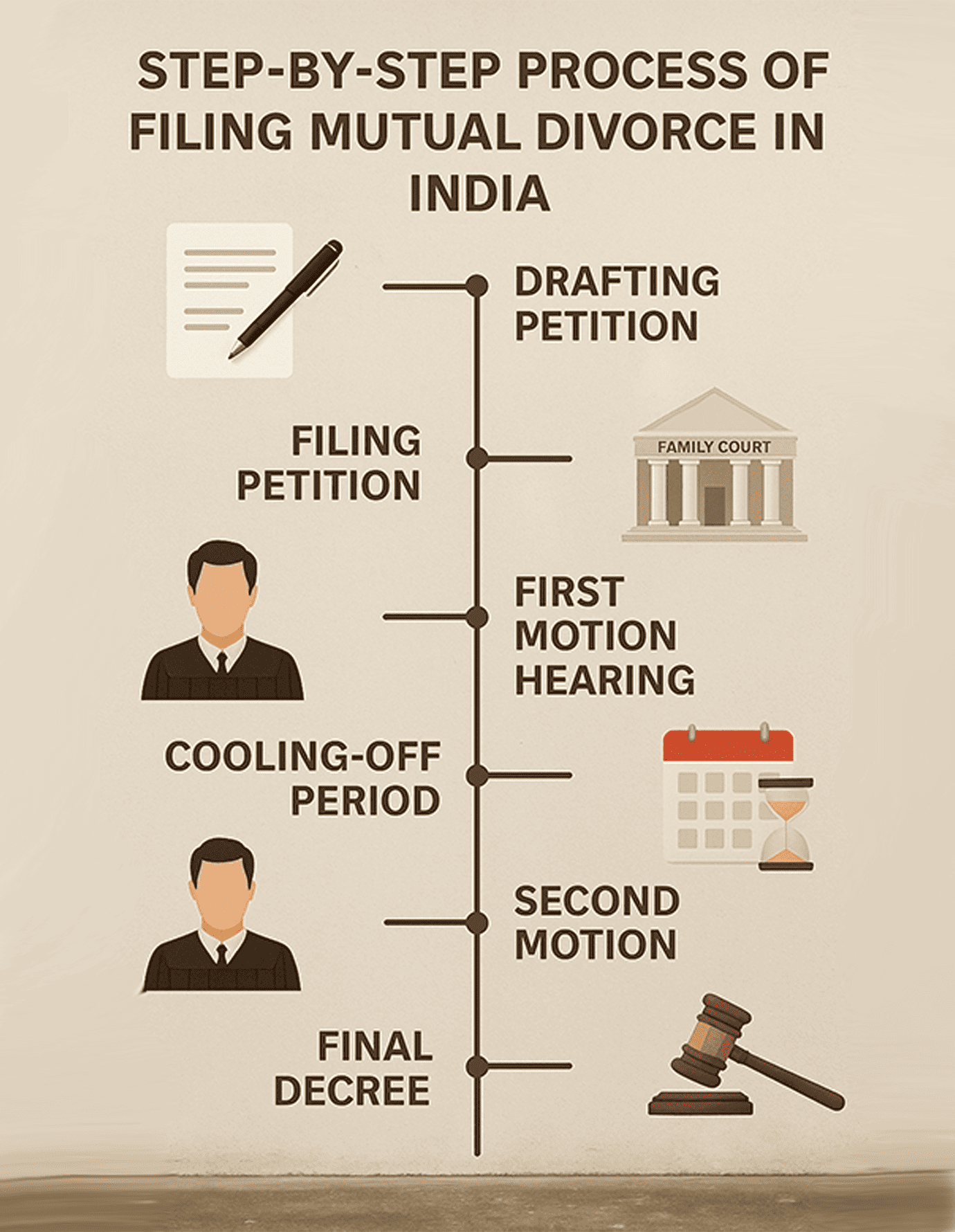
1. Drafting the Joint Petition
The first step is preparing a joint mutual divorce application that both spouses sign. This petition is drafted with the help of a lawyer and includes:
- Personal details of husband and wife.
- Date and place of marriage.
- Proof that they have been living separately as per the conditions for mutual divorce.
- A clearly defined mutual agreement covering issues like child custody, alimony, and property division.
The petition must be supported by the documents such as the marriage certificate, address proofs, and financial details.
2. Filing Petition Before Family Court
Once the petition is ready, it is filed before the appropriate family court along with the mutual divorce papers. Court fees are nominal, and the overall cost primarily depends on the lawyer’s professional charges and the complexity of the settlement. Filing ensures that the case is officially admitted for hearing.
3. First Motion Hearing
At this stage, both spouses appear before the judge with their mutual divorce lawyer. The court verifies the mutual consent and examines the contents of the mutual divorce application. If satisfied, the court records the statements of both parties and admits the petition.
4. Cooling-Off Period
After the first motion, the court imposes a cooling off period in mutual divorce, generally six months. This waiting time allows both spouses to reconsider their decision and attempt reconciliation, if possible. However, the Supreme Court has clarified that this period can be waived in certain circumstances, thereby reducing the time period.
5. Second Motion Hearing
Once the cooling off period is over (or waived), both parties must again appear before the family court for the second motion. The judge reassesses whether the decision to separate is still mutual. If both partners confirm their intent to proceed with the mutually agreed divorce, the case moves toward conclusion.
6. Final Decree of Divorce
If the court is satisfied that all conditions for mutual divorce have been met and that the mutual agreement is fair and balanced, it grants the final decree of divorce. This order legally dissolves the marriage and officially ends the marital relationship between the spouses.
The entire process—from filing the mutual divorce papers to obtaining the final decree—usually takes 6 to 18 months, depending on the time period and whether the cooling-off period is waived. With the guidance of an experienced lawyer, couples can ensure that the mutual divorce process is handled efficiently, all paperwork is complete, and the separation is finalized with dignity.
Documents Required for Mutual Divorce
For a mutual divorce to be accepted in court, both spouses must provide certain legal documents that support their petition. Proper paperwork ensures that the mutual divorce process moves smoothly and without unnecessary delays. The court relies on these documents to verify the authenticity of the marriage, the period of separation, and the terms of the mutual divorce agreement. Below are the essential documents needed:
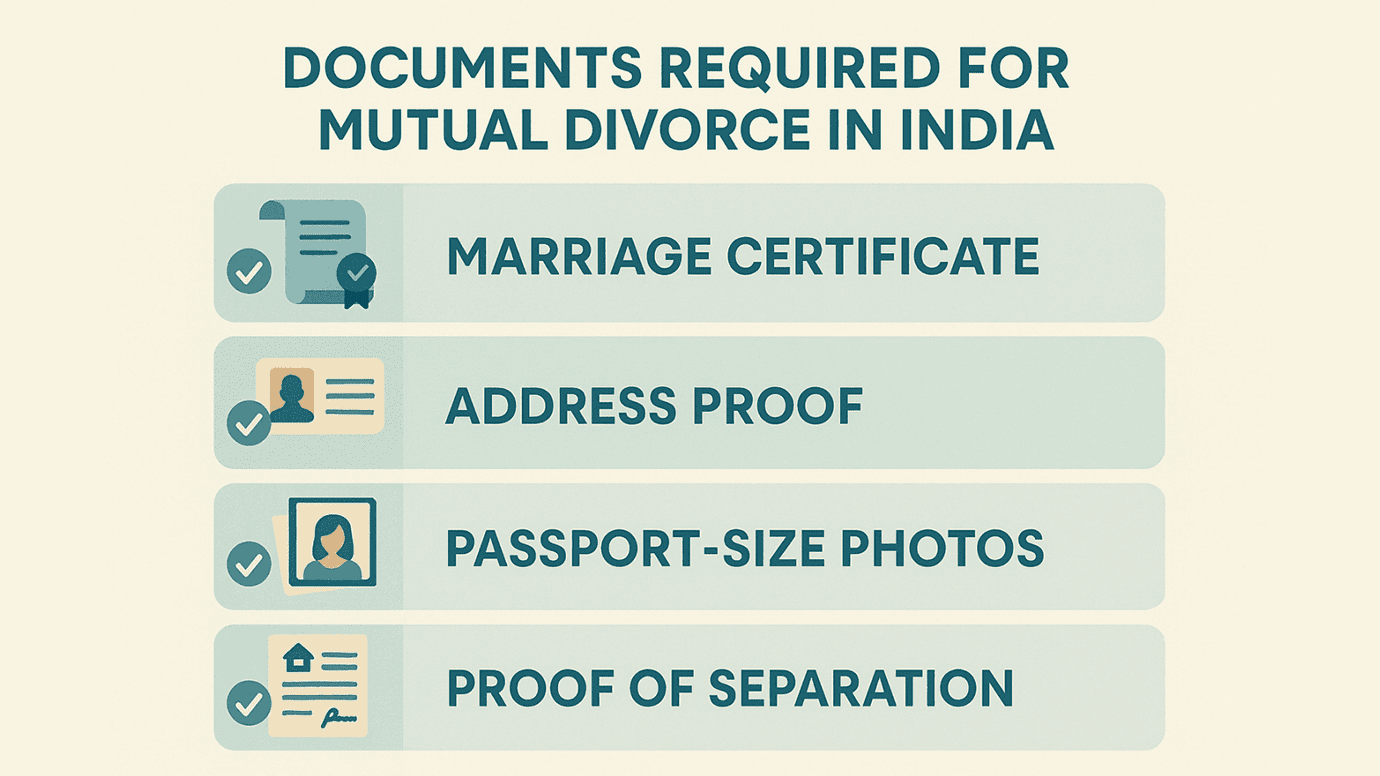
- Marriage Certificate: A marriage certificate is the primary document required to establish the legality of the marriage. Without this, the mutual divorce process cannot proceed, as the court must first confirm that a valid marriage exists.
- Address Proof of Husband and Wife: Both spouses must submit valid address proof such as Aadhaar card, voter ID, passport, or driving license. This ensures jurisdiction and helps the court confirm the permanent residence of the parties involved in the mutual divorce.
- Passport-Size Photographs: Recent passport-size photos of both husband and wife are typically attached to the application. These are used for official records throughout the mutual divorce process.
- Proof of Separation (if any): While not mandatory, any proof of separation—such as rental agreements, utility bills showing different addresses, or notarized documents—can strengthen the case by proving that the couple has been living apart as required under the conditions for mutual divorce.
Mutual Divorce Agreement on Key Issues
One of the most crucial parts of the paperwork is the mutual divorce agreement. This document outlines how both parties have settled vital issues such as:
- Alimony or Maintenance – Whether it is a one-time settlement or ongoing support.
- Child Custody – Custody arrangements, visitation rights, and financial responsibilities for children.
- Division of Property and Assets – Clear distribution of movable and immovable assets.
This agreement assures the court that the mutual divorce is truly consensual and that both spouses have resolved matters without dispute.
Why Complete Documentation Matters
Submitting all required documents accurately is critical to avoiding delays in the mutual divorce process. Courts may reject or postpone petitions if the paperwork is incomplete. With the guidance of a competent lawyer, couples can ensure that their mutual divorce agreement and supporting papers are drafted correctly and in compliance with the law.
The documents required for mutual divorce not only validate the marriage and separation but also demonstrate that both parties have responsibly addressed financial, custodial, and property matters before approaching the court.
Timeline – How Long Does Mutual Divorce Take?
One of the biggest advantages of choosing a mutual divorce over a contested divorce is the shorter and less stressful process. However, the actual time period depends on several legal requirements and the court’s discretion.
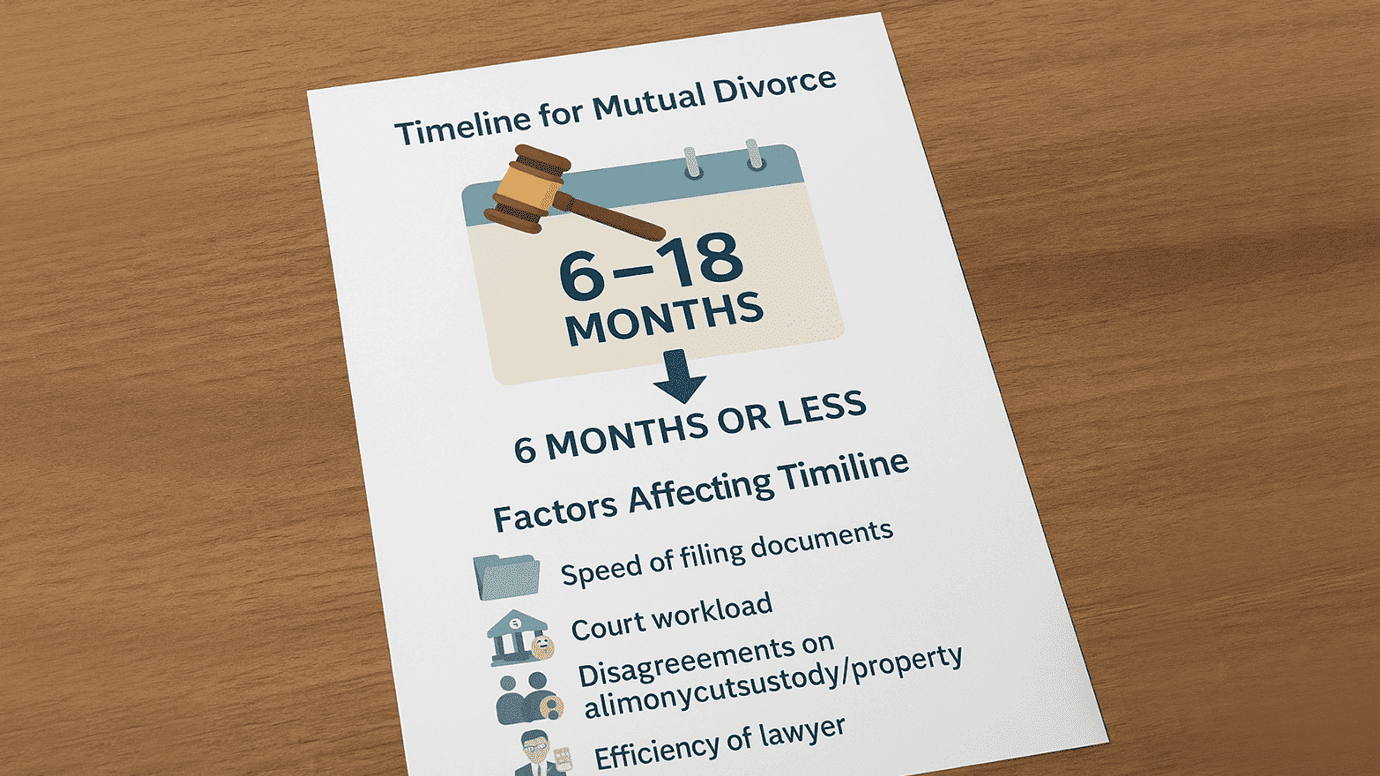
Normal Duration (6–18 Months)
In most cases, the mutual divorce process in India takes anywhere between 6 to 18 months. This includes the time for filing the mutual divorce application, the hearings in court, and the statutory cooling off period. The six-month waiting period is given after the first motion to allow both spouses to reconsider their decision before proceeding to the second motion.
Waiver of Cooling-Off Period
The Supreme Court of India has clarified that the cooling off period in mutual divorce is not mandatory in every case. If the marriage is beyond reconciliation and both spouses firmly believe that continuing together is impossible, the family court has the power to waive this waiting period. In such situations, the mutual divorce process can be completed in 6 months or even less, provided all paperwork is in order and both parties appear before the court as required.
Factors Affecting the Timeline
The exact time period can vary depending on:
- How quickly the mutual divorce papers and supporting documents are filed.
- The workload and schedule of the family court.
- Whether there is any disagreement on alimony, custody, or property division before signing the agreement.
- The efficiency of the chosen mutual divorce lawyer in guiding the couple through the process.
While the normal mutual divorce process in India takes about 6–18 months, with proper preparation, legal guidance, and a waiver of the cooling off period, the process can be significantly shortened, helping couples achieve closure and move forward in life faster.
Cost of Mutual Divorce in India
When couples decide to opt for a mutually agreed divorce, one of the most common concerns is the overall expense involved. Compared to contested divorces, the mutual divorce process in India is significantly more cost-effective because it involves fewer hearings, less conflict, and quicker resolution. Still, the cost in India varies depending on several factors, such as the city of filing, complexity of the settlement, and the professional fees of the lawyer.
- Court Fees: The court fees for filing a mutual divorce application are generally nominal. In most states, this cost ranges between ₹500 and ₹2,000. Since the mutual divorce process is based on mutual consent and requires joint filing, the court does not impose heavy charges.
- Lawyer’s Fees: The larger portion of the mutual divorce cost in India comes from the professional fees of the lawyer. Depending on the lawyer’s experience, the city, and the complexity of the case, fees can range from ₹25,000 to ₹1,00,000. An experienced lawyer ensures that the mutual divorce papers are drafted accurately, the process runs smoothly, and both parties’ interests are protected through a fair settlement.
Factors Affecting the Cost
Several factors can influence the total expenses in a mutually agreed divorce:
- Alimony or Maintenance: If one spouse seeks financial support, negotiations and drafting of a fair settlement can increase costs.
- Child Custody Arrangements: Disputes or detailed agreements regarding custody and visitation rights may involve additional lawyer consultation.
- Division of Property/Assets: Complex property settlements can add to the cost, as they require careful drafting of agreements.
- Documentation & Appearances: The number of hearings attended and additional paperwork may also slightly affect overall costs.
In short, while the mutual divorce process is far more affordable than contested proceedings, couples should budget for court fees and professional charges of a lawyer. With proper guidance, the mutual divorce process can be completed not only quickly but also at a reasonable cost, ensuring fairness for both parties.
Role of a Mutual Divorce Lawyer
A mutual divorce is often considered the simplest and most amicable way to end a marriage. However, even though the process is less complicated than a contested divorce, professional legal assistance is still crucial. An experienced mutual divorce lawyer ensures that the process is handled smoothly, that both parties’ rights are protected, and that the court proceedings are completed without unnecessary delays.

Why Legal Guidance is Important
- Drafting the Petition and Agreement: The first step in the mutual divorce process is preparing a joint petition supported by a clear agreement. A mutual divorce lawyer carefully drafts these documents to include all important details—such as alimony, child custody, and property division—so there are no disputes later.
- Negotiating Fair Terms: Even in a mutually agreed divorce, disagreements may arise regarding financial support or asset division. A skilled lawyer helps both parties negotiate and reach a fair, legally binding settlement, ensuring that neither spouse feels disadvantaged.
- Court Filing and Representation: Filing mutual divorce papers and appearing before the court requires adherence to specific legal procedures. A mutual divorce lawyer takes care of all technicalities—filing the petition, attaching the required documents, and representing clients in hearings. This minimizes errors and prevents delays in the process.
How a Lawyer Helps in Smooth & Faster Resolution
- Guidance on Legal Provisions: A lawyer explains every step of the mutual divorce process, including timelines, the cooling-off period, and required documentation.
- Avoiding Delays: With proper drafting and filing, a mutual divorce lawyer helps complete the process faster, sometimes even within six months if the court waives the waiting period.
- Ensuring Compliance: Courts only grant a mutual divorce when all legal conditions are met. A lawyer ensures full compliance, reducing the risk of rejection or repeated filings.
The role of a mutual divorce lawyer is indispensable. From drafting and negotiations to representation in court, their expertise ensures that the process is not only smooth and efficient but also fair for both spouses.
FAQs
A.Yes, the cooling off period in mutual divorce can be waived by the court if it is clear that the marriage cannot be saved and both spouses are firm in their decision. This helps shorten the mutual divorce process significantly.
A.The documents typically include the marriage certificate, address proof of both spouses, passport-size photographs, proof of separation, and the mutual divorce papers containing the settlement terms.
A.A mutual divorce lawyer drafts the mutual divorce papers, ensures compliance with the conditions, represents the spouses in court, and guides them through every step of the process.
A.A mutually agreed divorce is based on mutual consent, requires fewer hearings, and is cost-effective. In contrast, a contested divorce involves disputes, evidence, and multiple hearings, making it lengthier and more expensive than the mutual divorce process.
A.Yes, interfaith or civil marriages are governed by the Special Marriage Act 1954. Couples can file a mutual divorce by submitting a joint petition, provided they meet the legal conditions.
Conclusion
Choosing a mutual divorce is often the most practical and dignified way for couples to end their marriage. Unlike contested cases that drag on for years, the mutual divorce process in India is faster, less stressful, and more cost-effective. By relying on mutual consent, couples can avoid unnecessary conflicts and focus on reaching a fair and balanced settlement through a clear agreement.
Whether filed under Section 13B of Hindu Marriage Act 1955 or as a mutual divorce under Special Marriage Act 1954, the process provides couples with a lawful and peaceful option to separate. The court carefully examines the mutual divorce application, the documents, and ensures that all conditions are met. With the right guidance, the entire process can be completed within a reasonable time period, sometimes as short as six months if the cooling off period is waived.
One of the biggest benefits of a mutually agreed divorce is that it not only saves time but also reduces financial burdens. Since the mutual divorce cost in India is far lower compared to contested proceedings, couples can achieve closure without being weighed down by legal expenses. Moreover, with the expertise of a skilled lawyer, the petition, mutual divorce papers, and settlement terms are handled efficiently, ensuring compliance with legal requirements.
At Adlegal, we understand that divorce is not just a legal process but also an emotional journey. Our experienced family law team provides complete support—right from drafting the mutual divorce application to guiding you through court appearances—with confidentiality and compassion. If you are considering a mutual divorce, our lawyers can help you navigate the entire process smoothly, whether under Section 13B or the Special Marriage Act 1954. For more information regarding our services, go to our Homepage.
Disclaimer:
This blog is intended for educational and informational purposes only. It should not be taken as legal advice or relied upon as such. Cases of mutual divorce are sensitive and often vary based on individual circumstances, which may affect the legal remedies available.
If you or someone you know is facing such challenges, it is advisable to seek guidance from a qualified lawyer or legal professional. For safe and confidential support, you may also consider reaching out to trusted legal platforms such as Adlegal.


